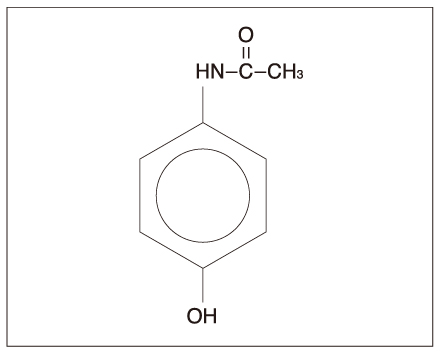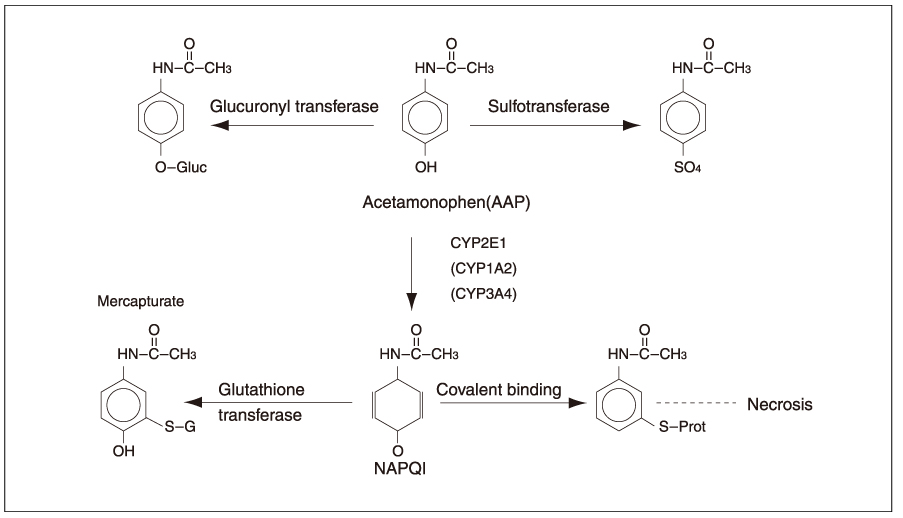J Korean Med Assoc.
2006 Sep;49(9):846-853. 10.5124/jkma.2006.49.9.846.
Acetaminophen-Induced Acute Liver Failure
- Affiliations
-
- 1Department of Internal Medicine/Laboratory of Disease Specific Diet Supplements, Boopyeong Serim Hospital, Korea. hepatox@paran.com
- KMID: 2137825
- DOI: http://doi.org/10.5124/jkma.2006.49.9.846
Abstract
- Acetaminophen (AAP) is an antipyretic and analgesic agent, which is sold under many brand names including Tylenol. Although AAP rarely induces hepatotoxicity by an idiosyncratic mechanism, it is one of intrinsic hepatotoxins with a narrow therapeutic window. The overdose of AAP is the single most common cause of acute liver failure in the United States. In Korea, recent increase of working parents adds to the cause of overlooking children's AAP intoxication. Therapeutic dose of AAP is mostly converted to an inactive compound in the liver by conjugation with sulfate and glucuronide, with a small fraction (less than 5%) metabolized via the cytochrome P-450(CYP) system. The CYP enzymes oxidize AAP to produce a highly reactive metabolite: N-acetyl-p-benzoquinone imine (NAPQI), which is detoxified in the liver by conjugation with hepatic glutathione (GSH). In case of AAP overdose a large amount of NAPQI depletes hepatic glutathione. Then the excess NAPQI binds to hepatocellular proteins, initiating cell death. The toxicity of AAP may be enhanced by agents that either increase the production of NAPQI or reduce the supply of GSH. N-acetylcysteine(NAC) replenishes hepatic GSH, thereby detoxifying NAPQI. Early administration of NAC minimizes the hepatotoxicity. In general the survival rate from AAP-induced acute liver failure has been increased with the use of NAC and liver transplantation.
Keyword
MeSH Terms
Figure
Reference
-
1. Liu ZX, Kaplowitz N. Role of innate immunity in acetaminophen-induced hepatotoxicity. Expert Opin Drug Metab Toxicol. 2006. 4:493–503.
Article2. Zimmerman HJ. The spectrum of hepatotoxicity. Perspect Biol Med. 1968. 12:135–161.
Article3. Anand AC, Nightingale P, Neuberger JM. Early indicators of prognosis in fulminant hepatic failure: an assessment of the King's criteria. J Hepatol. 1997. 26:62–68.
Article4. Schiodt FV, Atillasov E, Shakil AO, Schiff ER, Caldwell C, Kowdlev KV, et al. Etiology and outcome for 295 patients with acute liver failure in the United States. Liver Transpl Surg. 1999. 5:29–34.
Article5. Manyike PT, Kharasch ED, Kalhorn TF, Slattery JT. Contribution of CYP2E1 and CYP3A to acetaminophen reactive metabolite formation. Clin Pharmacol Ther. 2000. 67:275–282.
Article6. Lee WM. Acute liver failure. Syllabus for the American Association for the Study of Liver Disease Postgraduate Course. 2000. Dallas:7. O'Grady JG, Gimson AE, O'Brien CJ, Pucknell A, Hughes RD, Williams R. Controlled trials of charcoal hemoperfusion and prognostic factors in fulminant hepatic failure. Gastroenterology. 1988. 94:1186–1192.8. Zimmerman HJ, Maddrey WC. Acetaminophen(paracetamol) hepatotoxicity with regular intake of alcohol: analysis of instances of therapeutic misadventure. Hepatology. 1995. 22:767–773.
Article9. Mitchell JR, Jollow DJ, Potter WZ, Gillette JR, Brodie BB. Acetaminophen-induced hepatic necrosis. IV. Protective role of glutathione. J Pharmacol Exp Ther. 1973. 187:211–217.10. Smilkstein MJ, Knapp GL, Kulig KW, Rumack BH. Efficacy of oral N-acetyl-cysteine in the treatment of acetaminophen overdose. Analysis of the national multicenter study(1976 to 1985). N Engl J Med. 1988. 319:1557–1562.
Article11. Sanyal AJ, Stravitz RT. Zakim D, Boyer TD, editors. Acute liver failure. Hepatology. 2003. 4th ed. Philadelphia: Saunders;445–496.
Article12. Schiodt FV, Rochling FA, Casey DL, Lee WM. Acetaminophen toxicity in an urban country hospital. N Engl J Med. 1997. 337:1112–1117.13. Zimmerman HJ. Zimmerman HJ, editor. Indirect cytototoxic hepatotoxins. Hepatotoxicity. 1999. Philadelphia: Lippincott Williams & Wilkins;255–294.14. de Morais SM, Uetrecht JP, Wells PG. Decreased glucuronidation and increased bioactivation of acetaminophen in Gilbert syndrome. Gastroenterology. 1992. 102:577–586.
Article15. Prescott LF. Paracetamol: past, present, and future. Am J Ther. 2000. 7:143–147.16. Keays R, Harrison PM, Wendon JA, Forbes A, Gove C, Alexander GJ, et al. Intravenous acetylcysteine in paracetamol induced fulminant hepatic failure: a prospective controlled trial. BMJ. 1991. 303:1026–1029.
Article17. Makin AJ, Wendon J, Williams R. A 7-year experience of severe acetaminophen-induced hepatotoxicity(1987-993). Gastroenterology. 1995. 109:1907–1916.
Article18. Bailey B, McGuigan MA. Management of anaphylactoid reactions to intravenous N-acetylcysteine. Ann Emerg Med. 1998. 31:710–715.19. Perry HE, Shannon MW. Efficacy of oral versus intravenous N-acetylcysteine in acetaminophen overdose: results of an open-abel, clinical trial. J Pediatr. 1998. 132:149–152.
Article20. Kobayashi N, Noguchi H, Watanabe T, Matsumura T, Totsugawa T, Fujiwara T, et al. A new approach to develop a biohybrid artificial liver using a tightly regulated human hepatocyte cell line. Hum Cell. 2000. 13:229–235.21. Koivusalo AM, Vakkuri A, Hockerstedt K, Isoniemi H. Experience of MARS therapy with and without transplantation in 101 patients with liver insufficiency. Transplant proc. 2005. 37:3315–3317.
Article22. Makin AJ, Williams R. Acetaminophen-induced hepatotoxicity: predisposing factors and treatments. Adv Intern Med. 1997. 42:453–483.
- Full Text Links
- Actions
-
Cited
- CITED
-
- Close
- Share
- Similar articles
-
- A Case of Acetaminophen-induced Acute Interstitial Nephritis Presenting with Acute Renal Failure
- A Case of Acute Hepatic Failure due to Acetaminophen Overdose Treated with Molecular Adsorbents Recirculating System(R)
- A Case of Acute Renal Failure Induced by Acetaminophen Intoxication
- Animal Models of Acute Hepatic Failure
- The Clinical Use of the Plasma Acetaminophen Halflife in NAC-treated Acetaminophen Overdose



